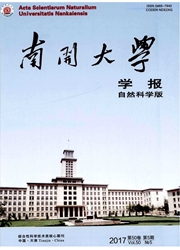

 中文摘要:
中文摘要:
研究了不同锂含量的双掺铁锰铌酸锂晶体的紫外光致吸收特性,结果表明,同成分晶体的紫外光致吸收系数较低,随着锂含量的增加,晶体的紫外光致吸收系数逐渐增大,当晶体中的锂含量达到49.57mol%附近时,紫外光致吸收系数达到最大值4.20cm^-1,进一步增加晶体中的锂含量,饱和光致吸收系数开始下降。在此基础上,提出了近化学计量比双掺铁锰铌酸锂晶体的双色非挥发全息存储的三中心模型,即随着晶体锂含量的增加,双掺铁锰晶体的光折变中心除了Fe^2+/Fe^3+,Mn^2+/Mn^3+外,还将增加双极化子/小极化子中心。
 英文摘要:
英文摘要:
The ultraviolet light induced absorption change (UV-LIA) of nearly stoichiometrie LiNbO3 : Fe : Mn crystals was investigated. The experimental results show that the UV-LIA coefficient change of LiNbO3 : Fe : Mn crystal is not large for congruent sample, increases with increasing Li2O concentration, reaches the maximum 4.2 cm^-1 at about 49. 57 mol% Li2O, and then decreases with further increasing Li2O content. Because the UV-LIA change has a direct relationship with the nonvolatile holographic sensitivity, the experimental results indicate that the nearly stoichiometric LiNbO3 : Fe : Mn crystal with 49. 57 mol% Li2O is the appropriate candidate material for the nonvolatile holographic storage. The visible light induced bleaching resuits also prove that the suitable composition is 49.57 mol%. With the increase in LizO concentration in the LiNbO3 : Fe : Mn crystal, the amount of the bipolaron increases. Bipolarons may be dissociated either optically or thermally so that metastable small polarons are formed. The energy level for biopolaron and small polaron is at about 2.5 and 1.6 eV respectively. When the Li2O concentration continues to increase, the small polarons are dominating intrinsic defects. The bipolarons have stronger photorefractive capability than the small polarons. The amount of bipolaron is the most with 49.57 mol% Li2O concentration in the LiNbO3 : Fe : Mn crystal. Based on these experimental results, a three-photorefractive-centers model in nearly stoichimetric LiNbO3 : Fe : Mn crystal is suggested: besides Fe2^+/Fe^3+ and Mn^2+/Mn^3+ , bipolarons/small polarons are considered as the third photoactive center.
 同期刊论文项目
同期刊论文项目
 同项目期刊论文
同项目期刊论文
 期刊信息
期刊信息
